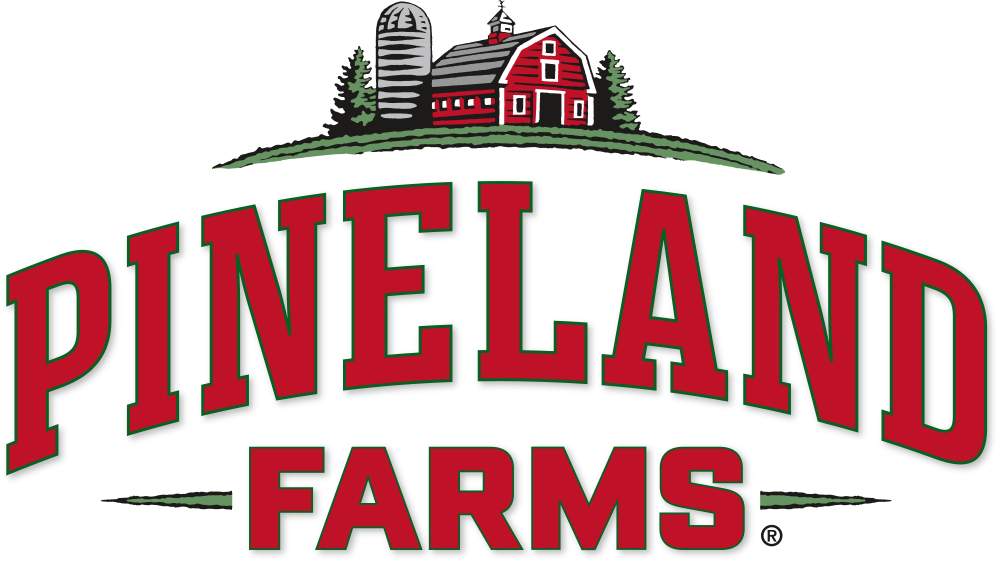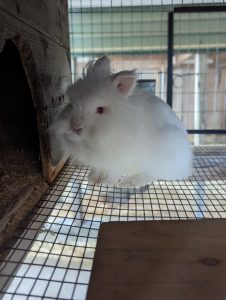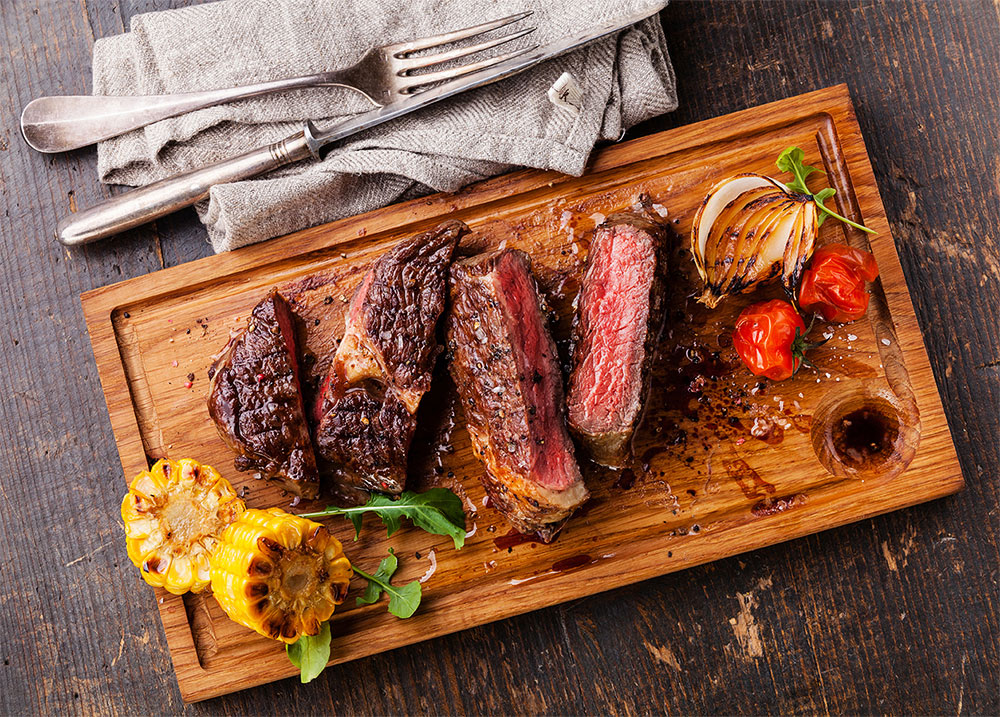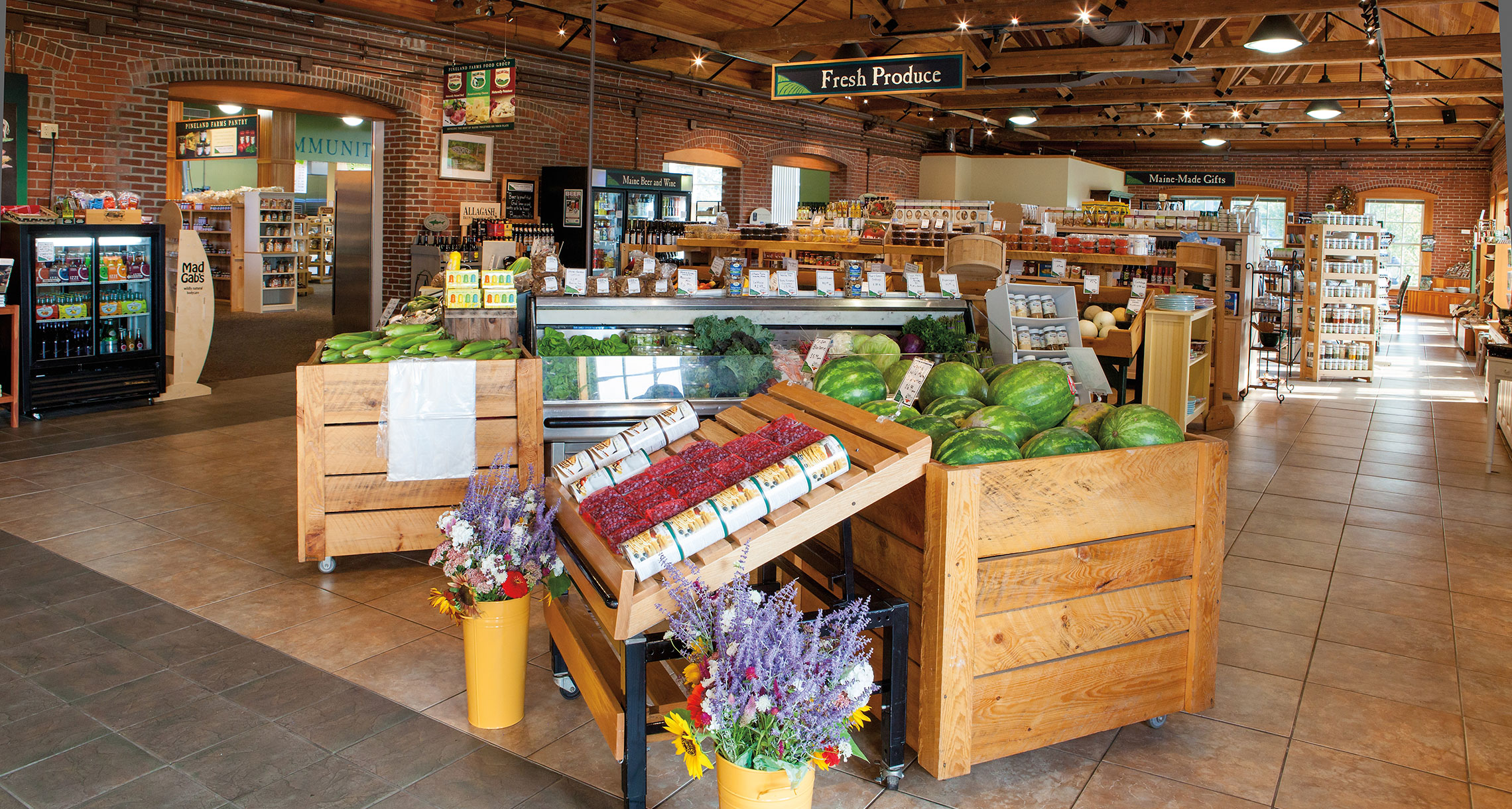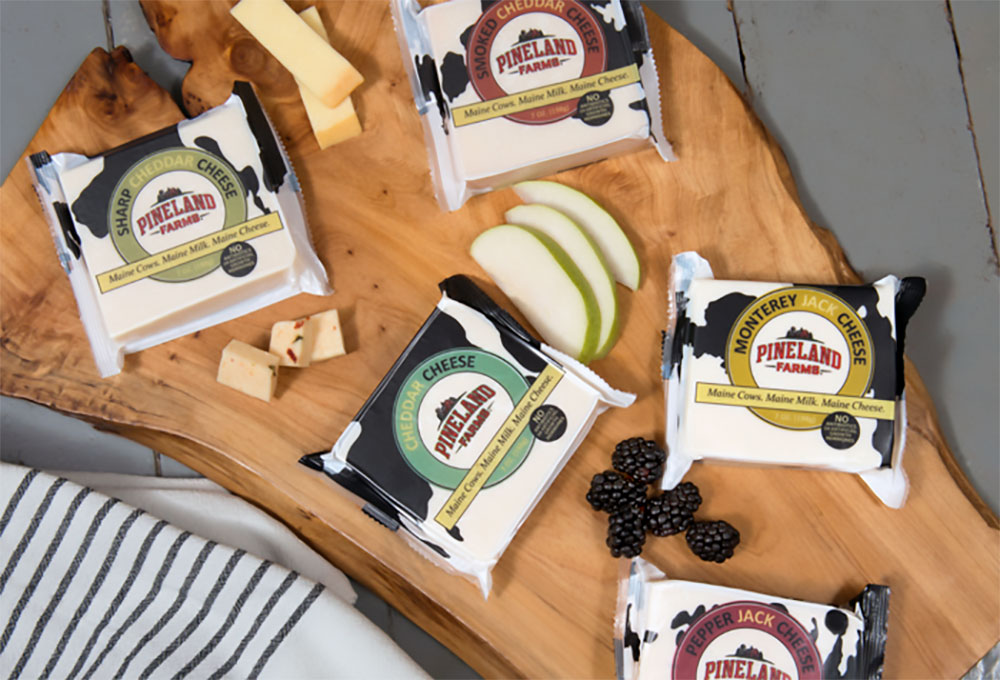Farmyard Friends
A 2 hour Farm Pass is needed to access both our Farmyard (Educational Venue) and Valley Farm (Working Dairy Farm) for a self-guided tour and to meet all the farm animals. The farmyard is open daily year-round and is home to our Farmyard Friends like laying hens, goats, sheep, and peafowl. It also has an engaging outdoor play area. Beginning in mid-May and continuing through September, we welcome our Summer Farmyard Residents to our pastures, a wider variety of animals from local farms including alpaca, pigs and more. In June, July and August of each summer we offer educator led hourly activities in the farmyard, some of which could include hand milking a Holstein cow, collecting chicken eggs or meeting the sheep. To learn about different farming methods, animal jobs and products, or ask us your farm animal questions, Contact Education at education@pinelandfarms.org or 207.650.3031.
Here are some of the Farmyard Friends you’ll meet all year round:
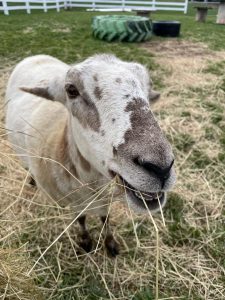 Peach
Peach
Born 4/6/2019
Katahdin Ewe
Peach came to us in December 2020. Her roommate is Francine. They were a little nervous when they first met but soon became best friends. Peach loves chin and nose scratches. She likes the occasional snack as well, either a small handful of grain or some baby carrots.
The Katahdin breed was developed in Maine. They are a hair breed, so instead of growing a thick wool coat she has a short dense hair coat. She does not need to be sheared, her hair will naturally shed in the spring.
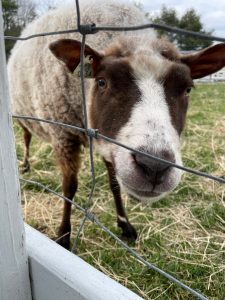 Francine
Francine
Born 3/23/2019
Finnish Landrace Sheep
Francine loves to be the center of attention. She is often right at the fence of her pen looking for pets from us and visitors. As soon as you stop petting her or if you’re in the barn and not paying attention to her she will Baa very loudly until you turn your attention to her. She is very bonded with us and loves when we go in her pen and sit with her. She will sit beside us and lay her little head on our laps.
Finnish Landrace or Finnsheep, were first imported from Finland to North America by the University of Manitoba, Canada in 1966.The breed is considered to be several hundred years old, descending from the mouflan that live in the wild on Sardinia and Corsica, They are also said to be related to other Scandinavian short-tailed sheep.
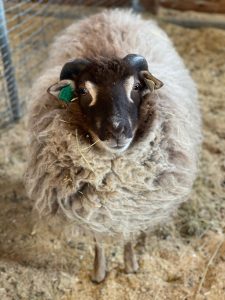 Pherdinand
Pherdinand
Born 4/15/2019
Shetland Sheep
Pherdinand and Phineas are brothers and best friends. Pherdinand has a slightly darker face and dark horns. They both are a little more shy than our other sheep but can be won over with a couple treats and chin scratches.
Phineas and Pherdinand came from “A Wing & A Prayer Farm” of Shaftsbury, VT. Shetland sheep are a small breed that produce a beautiful high-quality fleece every year. Their fleece comes in 11 colors.
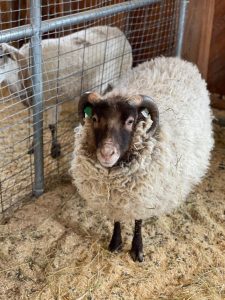 Phineas
Phineas
Born 4/15/2019
Shetland Sheep
Phineas has a lighter nose & lighter horns. Phineas and Pherdinand absolutely love their turn to be outside in the pasture and really enjoy running around with Peach and Francine. They are both wethers.
Phineas and Pherdinand have small spiral horns. Depending on the breed, both male and female sheep can have horns. In the Shetland breed, females do sometimes have horns, but they do not spiral. As Phineas and Pherdinand age their horns will continue to grow. Shetland sheep originate from the Shetland Islands in Scotland. They will grow to be 90-120 lbs. Shetland sheep produce 2-4 lbs. of fleece every year. They can be sheared once or twice a year depending on farmers preference.
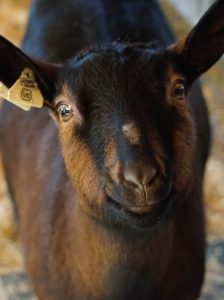 Puck
Puck
Born 3/18/2019
Oberhasli Goat
Puck is dark reddish/brown and has a black stripe down the center of his back. He is the only boy in our goat herd. Puck is very friendly and loves to be near everyone; goat or human. Like Tansy, he loves all treats and is also very fond of chin and neck scratches. If you stop petting him before he’s ready to be done, he will pick up one of his front hooves and gently pat you on the leg until you resume petting him.
Oberhasli are an American breed of dairy goat with gentle dispositions. Puck will grow to be 30-34 inches tall at the withers and 150 lbs.
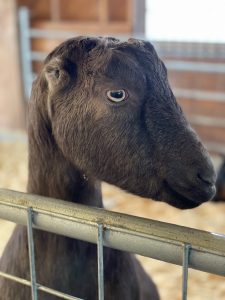 Tansy
Tansy
Born 3/30/2019
LaMancha Goat
Tansy looks different from our other three goats because she appears to not have any ears. This is a characteristic of her breed; all Lamanchas are born with very short or no ears. Tansy is the youngest but biggest goat in our herd. We refer to her as the Herd Queen as she seems to be the boss in the goat pen. We have yet to find a treat that she won’t eat. In the winter, Tansy and Puck love to go outside and run in fresh snow.
She will grow to be about 28 inches at the withers and 130 lbs. The goats here at Pineland Farms serve two purposes, to teach our guests about goats and the products that can be made from their milk and to keep our pastures under control.
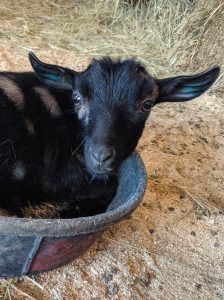 Poppy
Poppy
Born 3/5/2019
Nigerian Dwarf Goat
Poppy is black with tan spots, known as “moonspots” She is the oldest, yet smallest, member of our goat herd. As a dwarf goat she is about half the size of our full size goats and easily mistaken for a baby goat. Poppy is the most independent of the herd and is often found out in the pasture by herself grazing or soaking in the sunshine. Poppy loves treats like all goats do, but is a little pickier than Puck and Tansy and likes to give everything a good sniff before she’ll try it.
Nigerian Dwarf goats were first raised in the US for show and as pets. They have since been found to be quality dairy animals and are capable of producing up to 2 quarts of milk daily. Their milk is known for being high in protein and butterfat content which makes its excellent for cheese production.
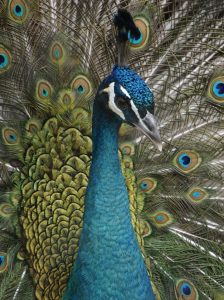 Zeus
Zeus
Born 4/2016
Indian Blue Peacock
Zeus is full grown. This year his tail will be 5-6ft long. Every fall, Zeus goes through a process called molting, this is when all of his tail feathers fall out so he can grow new ones. For the first 4-5 years of his life his tail gets longer after each molting. You have the best chance of catching him with his tail up or hear him honking if you visit anytime from April to August.
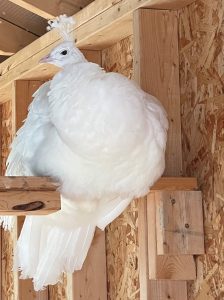 Hera
Hera
Born 5/2016
Indian Blue Peahen
Hera is full grown. Most peahens are brown and look more like turkeys, however as you can see Hera is all white. This is because of a genetic mutation called leucism, which means that her feathers lack melanin. We think it makes her look like she’s always wearing a wedding dress. Just like our chickens, Hera lays eggs. She lays eggs from April to August. Her eggs are all white and are about twice the size of our chicken eggs.
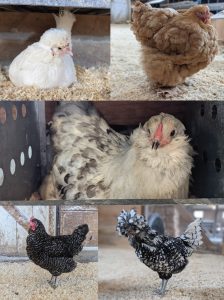 The Farmyard Flock
The Farmyard Flock
The Farmyard flock has 8 hens and 1 rooster that are 6 different breeds. We have Cochin, Polish, White Sultan, Ameraucana, Phoenix, and Mille Fleur breeds.
Our diverse small flock of chickens is very fun to look at. Some of them have large crests of feathers on top of their heads, some have feathers covering their legs and feet, and one chicken has both. No two chickens in this flock have the same exact color pattern on their feathers. These hens, while not as productive as our Golden Comets, still each give us 3-4 eggs a week depending on the season. With the different breeds, comes different egg colors; our farm educators collect white, tan, brown, blue, and sometimes even green eggs. Since there are only 9 chickens in this flock we are able to see and enjoy all their individual personalities and quirks such as: Survivor loves to sit in the nesting box all day long, Dolly is always digging herself holes to dust bathe in, Slug is perfectly content to stay in the coop at all times, and if an egg is found out in the Farmyard it’s probably Yolko’s.
Our whole flock: Slug, Dolly Parton, Survivor, Evelyn, Yolko Ono, Pineapple, Hot Sauce, Garbanzo, and Croissant.
 Our production flock of chickens
Our production flock of chickens
Each year, we introduce 175 new chicks to our production flock of chickens . This year, our chicks were hatched on May 6th 2025 and they arrive on the farm at only a few days old via USPS.
The chicks will be in their brooder space under heat plates for the first 6-8 weeks of their lives, and then will have free run of half of our chicken coop and the outside chicken pasture. When they reach about 5 months old they will begin to lay eggs and should be at full production about a month after they begin laying.
Our flock consists of Red, Black, and Amber Sex-link chickens that are a hybrid breed created by crossing Rhode Island Red roosters and Leghorn, White Plymouth Rock, and Barred Rock hens, respectively. They have been bred to be not only excellent egg-layers but also a very hardy and easy to care for breed. They are called Sex-links because unlike most other chicken breeds, you can distinguish the males and females from each other immediately after hatching.
Each one of the hens lays one medium-sized brown egg about every 26 hours, so our farm educators collect between 160-320 eggs daily that get processed and sold at our Market!
Our chickens have a spacious coop where they nest, eat, and rest, and they also have an outside pasture where they can go hunt for bugs and worms, and enjoy the sunshine. Every night our educators make sure all the chickens are tucked inside the coop and close their outside door to keep them safe from predators. Another form of predator control that we use for our chickens is Harold, the decoy owl. Harold is moved around the perimeter of the fence tops to keep the resident red-tailed hawks away. Important members of the ecosystem, hawks and other birds of prey help control mice and voles populations on farms. However, hawks often threaten chickens, ducks or other fowl because they are such keen predators.
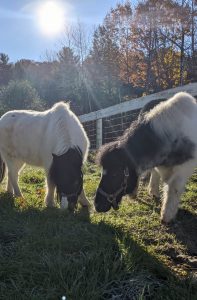 Tango & Velvet
Tango & Velvet
Born 3/6/06 & 4/9/05
Shetland Ponies
Tango has a white body and a mostly black head. He also has two different colored eyes; one brown and one blue! Velvet has large black spots on her head, neck, and rump. Velvet was once trained to be a cart pony. Velvet and Tango have been living together for over 10 years and are very bonded with each other. With any animal group there is usually a lead animal and we have found that for these two it seems to be Velvet. Tango likes to follow Velvet around and won’t leave the barn without her.
During the day you can find them outside in one of the Farmyard pastures and at night they are inside the Education Barn with the sheep and goats. Even in the winter they are outside during the day; one of their favorite activities is to frolic and roll in freshly fallen snow.
Lady Marmalade
Born 6/25/2021
Lionhead Rabbit
For our long-time farm visitors, doesn’t she look like Milkweed’s soul sister?! Thank you to Jack Rabbits Rabbitry for making her available to us.
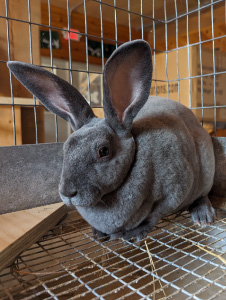 Empress Chutney
Empress Chutney
Born 4/10/2023
Rex Rabbit
Joining Lady Marmalade, is our new big eared friend, Empress Chutney. Empress is a Rex rabbit that was born 4/10/2023. Her beautiful blue fur is short and unbelievably soft.
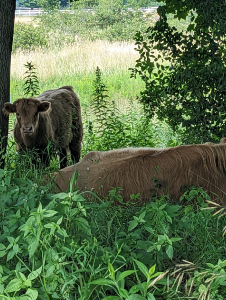 Highland Cattle
Highland Cattle
Stanley (F) Rona (F) Norma (F)
Born May 2018 Born April 2020 Born October 2023
Stanley is the oldest of our Highland cow herd and despite her typically male name, is a female. Rona is next in line and is the older sister to our youngest lady, Norma. Highland Cattle are easily recognized and known for their long shaggy hair and, as adults, their wide set curving horns. Highlands are most commonly an auburn red color but their hair can be blonde, silver, tan, red, or black. Rona and Norma are the classic red color and Stanley is blonde. Our beautiful Highland ladies like to spend most of their time grazing and lazing about in their large pasture. They will sometimes come close to the fence line and allow for some human interaction but mainly like to keep to themselves and their herd.
Highland Cattle originated in Scotland and were first recorded in the United States in the late 1890s. As a beef breed, Highlands are fast growing when young and females can weigh up to 1500 lbs when fully grown. They are a hardy breed that can thrive in different locations and climates, due mainly to their unique double coat of hair. Both female and male Highlands grow the long curving horns. On young cattle, the horns become noticeable around 6-7 months and continue to grow steadily until 2-3 years of age, at which time they will still grow but at a much slower rate.
 Millet or “Millie”
Millet or “Millie”
Adopted May 22, 2025
“Millie” (orange) was found living as an outdoor cat with a litter of kittens, but is well socialized with humans. We expect that she will be pleased to welcome all our visitors when not out exploring her new domain.
Farms are a great place for animals of all kinds to call home, unfortunately, even nuisance animals that can damage crops and transmit disease.
These two female felines (learn about Quinoa below) are part of our pest prevention program here at the farm and were selected for us by our friends at Harvest Hills Animal Shelter https://harvesthills.org/.
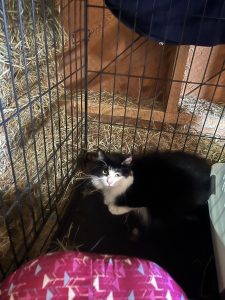 Quinoa or “QuiQui”
Quinoa or “QuiQui”
Adopted May 22, 2025
“Quiqui” (black & white) is more of a true feral cat and will likely only be spotted by a few visitors. Also, a mother to a litter of kittens, we expect that she will be the more dominant rodent control specialist.
Harvest Hills Animal Shelter is a non-profit organization (501c3) which contracts with 19 towns in Western Maine to accept neglected, stray, and abandoned cats and dogs. These animals are brought in by the towns’ animal control officers. When space is available, Harvest Hills also accepts owner surrendered animals from all surrounding communities in Maine and New Hampshire and will assist other shelters by providing a safe place for adoptable animals that would otherwise be euthanized, or did not fit another shelters admission policies. Learn more: https://harvesthills.org/.
